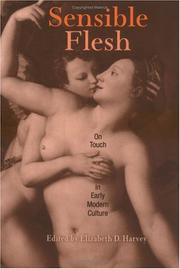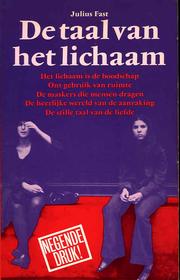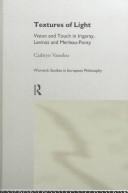| Listing 1 - 5 of 5 |
Sort by
|
Book
ISBN: 9789061319788 Year: 2003 Publisher: Utrecht : Bijleveld,
Abstract | Keywords | Export | Availability | Bookmark
 Loading...
Loading...Choose an application
- Reference Manager
- EndNote
- RefWorks (Direct export to RefWorks)
Dit handboek over de haptonomie is geschreven door de grondlegger van deze vorm van lichaamsgerichte therapie. Door middel van aanraking van de therapeut (meestal een fysiotherapeut) ervaart de patiënt blokkades van emotionele stress, die door middel van deze therapie verholpen kunnen worden. De haptonomie krijgt een grote belangstelling en bekendheid. De grondslagen en werkprincipes worden door Veldman behandeld in een uitvoerige wetenschappelijke verhandeling. Gebaseerd op existentieel-filosofische kennis waarbij aanraking door de tast een nieuwe affectief-existentiële bevestiging brengt aan het gevoelsleven. Veldman probeert met een geheel eigen terminologie de haptonomische inzichten uiteen te zetten. Het is daardoor een moeilijk leesbaar boek. Slechts de direct belanghebbende lezer van deze materie zal de moeite nemen om dit boek grondig te bestuderen, dat dan bijzondere inzichten omtrent probleemdefinities en therapeutische mogelijkheden zal bieden. Een boek voor de beroepspraktijk van de lichaamsgerichte therapie en voor deskundige professionals.
Book
ISBN: 9056371568 Year: 1998 Publisher: Rotterdam : Lemniscaat,
Abstract | Keywords | Export | Availability | Bookmark
 Loading...
Loading...Choose an application
- Reference Manager
- EndNote
- RefWorks (Direct export to RefWorks)
#KVHB:Gehandicapten --- #KVHB:Orthopedagogie --- 615.8 --- Basale stimulatie --- Behandelingen --- Haptonomie --- Logopedie --- Neuro Development Treatment --- Personen met een meervoudige handicap --- Petö --- Sensorische integratie --- Snoezelen --- Vojta --- 463 --- NDT --- gehandicapten --- haptonomie --- logopedie --- rehabilitatie (resocialisatie) --- revalidatie --- (zie ook: instellingen voor gehandicapten) --- Fysiotherapie --- Mensen met een verstandelijke beperking --- Fysiotherapeutisch onderzoek --- Kinesiologie --- Spelen --- Muziektherapie --- Physiotherapy. Alternative treatments --- personen met een meervoudige beperking --- Social policy and particular groups

ISBN: 0812218299 9780812218299 0812236939 0812293630 Year: 2020 Publisher: Philadelphia : University of Pennsylvania Press,
Abstract | Keywords | Export | Availability | Bookmark
 Loading...
Loading...Choose an application
- Reference Manager
- EndNote
- RefWorks (Direct export to RefWorks)
This ground-breaking interdisciplinary collection explores the complex, ambiguous, and contradictory sense of touch in early modern culture. If touch is the sense that mediates between the body of the subject and the world, these essays make apparent the frequently disregarded lexicons of tactility that lie behind and beneath early modern discursive constructions of eroticism, knowledge, and art. For the early moderns, touch was the earliest and most fundamental sense. Frequently aligned with bodily pleasure and sensuality, it was suspect; at the same time, it was associated with the authoritative disciplines of science and medicine, and even with religious knowledge and artistic creativity.The unifying impulse of Sensible Flesh is both analytic and recuperative. It attempts to chart the important history of the sense of touch at a pivotal juncture and to understand how tactility has organized knowledge and defined human subjectivity. The contributors examine in theoretically sophisticated ways both the history of the hierarchical ordering of the senses and the philosophical and cultural consequences that derive from it.The essays consider such topics as New World contact, the eroticism of Renaissance architecture, the Enclosure Acts in England, plague, the clitoris and anatomical authority, Pygmalion, and the language of tactility in early modern theater. In exploring the often repudiated or forgotten sense of touch, the essays insistently reveal both the world of sensation that subtends early modern culture and the corporeal foundations of language and subjectivity.
Feeling --- Haptic sense --- Haptics --- Haptonomie --- Haptonomy --- Sens et sensation --- Senses and sensation --- Tactile perception --- Tastzin --- Touch --- Toucher [Le ] --- Zintuigen en gewaarwording --- Touch. --- Senses and sensation. --- Toucher --- Sens et sensations --- Tactual perception --- Somesthesia --- Sensation --- Sensory biology --- Sensory systems --- Knowledge, Theory of --- Neurophysiology --- Psychophysiology --- Perception --- Cultural Studies. --- Literature. --- Medieval and Renaissance Studies.

ISBN: 9021427257 Year: 1975 Publisher: Amsterdam : Wetenschappelijke uitgeverij,
Abstract | Keywords | Export | Availability | Bookmark
 Loading...
Loading...Choose an application
- Reference Manager
- EndNote
- RefWorks (Direct export to RefWorks)
Dit lichtvoetige boek van de voortreffelijke populisator Fast doet ons veel zien wat we eerst niet waarnemen. En misschien heeft het ook wel invloed op ons gedrag: op de manier waarop wij omgaan met onze medemens. (Bron: covertekst)
Aanraken (haptonomie) --- Lichaamstaal --- Nonverbale communicatie (communicatie (non-verbale)) --- #KVHB:Lichaamstaal --- Sociolinguistics --- Mass communications --- 415 --- lichaamstaal (gez) --- lichaamstaal --- #GGSB: Psychologie --- #GGSB: Seksualiteit --- #GROL:SEMI-159.925 --- 061504.jpg --- 007 --- Linguistics --- Developmental psychology --- Semiotics --- psychomotoriek --- Affective and dynamic functions --- Psychology --- psychologie --- #GSDBP --- #GBIB:SMM --- #KVHB:Non-verbale communicatie --- Psychologie --- Seksualiteit --- Body language --- Book --- Communication

ISBN: 0415142741 9780415142748 Year: 1998 Volume: *2 Publisher: London: Routledge,
Abstract | Keywords | Export | Availability | Bookmark
 Loading...
Loading...Choose an application
- Reference Manager
- EndNote
- RefWorks (Direct export to RefWorks)
Eyesight --- Feeling --- Filosofie --- Haptic sense --- Haptics --- Haptonomie --- Haptonomy --- Licht --- Light --- Lumière --- Philosophie --- Philosophy --- Seeing --- Sight --- Tactile perception --- Tastzin --- Touch --- Toucher [Le ] --- Vision --- Vision (Physiologie) --- Wijsbegeerte --- Zien [Het ] --- Philosophy, French --- Irigaray, Luce --- Lévinas, Emmanuel, --- Merleau-Ponty, Maurice, --- Light. --- Touch. --- Vision. --- Senses and sensation --- Blindfolds --- Eye --- Physiological optics --- Tactual perception --- Somesthesia --- Electromagnetic waves --- Light sources --- Spectrum analysis --- Irigaray, Luce. --- Lévinas, Emmanuel. --- איריגארי, לוס --- Yiruigelai --- Lévinas, Emmanuel. --- Merleau-Ponty, Maurice --- Lévinas, E. --- Leṿinas, ʻImanuʼel --- Levinas, Emani︠u︡el --- לוינס׳ עמנואל --- לוינס, עמנואל --- Levinas, Emmanuel --- Līfīnās, Īmānwāl --- ليفيناس، إيمانوال --- Lévinas, Emmanuel --- Philosophy, French - 20th century --- Lévinas, Emmanuel, - 1906-1995 --- Merleau-Ponty, Maurice, - 1908-1961 --- Merleau-Ponty, Jean Jacques Maurice, --- Merlō-Ponty, Mōris, --- Ponty, Jean Jacques Maurice Merleau-, --- Ponty, Maurice Merleau-, --- מרלו־פונטי, מוריס,
| Listing 1 - 5 of 5 |
Sort by
|

 Search
Search Feedback
Feedback About UniCat
About UniCat  Help
Help News
News